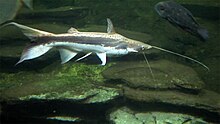Sorubim
| Sorubim | |
|---|---|
 |
|
| Sorubim lima | |
| Scientific classification | |
| Kingdom: | Animalia |
| Phylum: | Chordata |
| Class: | Actinopterygii |
| Order: | Siluriformes |
| Family: | Pimelodidae |
| Genus: |
Sorubim G. Cuvier, 1829 |
| Type species | |
|
Silurus lima Bloch & Schneider, 1801 |
|
| Synonyms | |
Sorubim is a small genus of long-whiskered catfish native to tropical South America. A number of characteristics allows the differentiation of each species in the genus. Sorubim species are important food fish in South America and are highly significant to fisheries of some areas; however, harvests of these fish are not identified as much as other, more popular food fishes such as Colossoma, Arapaima, and Brachyplatystoma. Some species of this family are popular aquarium fish.
The genus name is derived from a Brazilian local name, sorubí. The description of Sorubim has been attributed to both Cuvier and Agassiz in 1829, but because Cuvier's description predates that of Agassiz by two months, Cuvier's is valid. Later, Sorubim lima, originally described as Siluris lima in 1801, was designated as the type species by Bleeker in 1862.
In 2007, this genus was reviewed, validating five species.S. lima and S. trigonocephalus are redescribed in this paper. This genus is monophyletic.
The currently recognized species in this genus are:
Sorubim is a widely distributed genus, collected from many major river basins in 10 countries.S. lima is the most widely distributed species of the genus, found east of the Andes in the Amazon, Orinoco, Paraná, and Parnaíba basins. Initially it did not occur in the upper Paraná basin above the Guaíra Falls, but these disappeared after the contruction of the Itaipu Dam, allowing this species (and several others) to spread. It is syntopic with S. elongatus in the Orinoco basin and with S. elongatus and S. maniradii in the upper Amazon drainage of Brazil, Ecuador, Peru, and Bolivia.S. maniradii was discovered in the Napo and Yasuni River drainages of Ecuador, but also occurs in other tributaries of the Amazon.S. elongatus is found in the Amazon, Orinoco, and Essequibo River basins.S. cuspicaudus is found in northern Colombia and inhabits Lake Maracaibo, Sinu River, Cauca River, and Magdalena River basins.S. trigonocephalus was initially considered very rare as only three specimens were known by 2007. Later many more specimens have been collected and the species is relatively common. It is found only in the Tapajós and Xingu basins in Brazil. The type locality of S. trigonocephalus has been reported as the Madeira River, but the species does not occur there and the correct locality is now recognized to be the Arinos River, a part of the Tapajós basin.
...
Wikipedia
